They used us?
The education reform oligarchy set an agenda, carefully selected their mode of operations, and agreed upon the bait. They developed a vision, knew what they needed to do, how to do it, and they had the monetary and political support to move a nation to do their bidding. They used us to advance their plan.
With wisely selected words, they tapped into our frustration with bureaucracies and BIG government while marketing their wares, following their map, and sticking to their strategies — repeatedly and relentlessly.
They used mass messaging, mass media, and massively powerful organizations to launch and continue to float THEIR mass movement.  To succeed with their plan, the oligarchy needed to undermine what was a strong public institution.
To succeed with their plan, the oligarchy needed to undermine what was a strong public institution.
There was never any dispute that schools need to constantly be improving themselves and that unequal access to quality education exists because of socioeconomic factors.
And the oligarchy always claimed their plan was about systemic improvements.
At this point, I challenge the notion that their agenda was ever about educational improvement.
Did they really care about this country’s future?

American Federation of Teachers, National School Board Association, and the National Education Association went along with the recommendations while ignoring the fact that the plan was market-based from its inception.
Business people look at markets. The oligarchy faced a fact, parents liked their schools. So, they expanded their market shares by creating an illusion of need. Their public persuasion took several forms.
They used us.
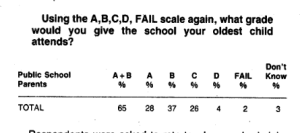
This 1986 public poll shows that very few parents thought their schools were failing. (For the record, I began seeing a systems’ failure to address the goal of equal opportunity.)They Used Us:
THEY TARGETED A POPULATION.
The marketing plan needed to target a politically active portion of the population who mostly lacked any real contact with —or direct knowledge of— the reality of our schools.
May 27, 1986
”Voters understand that to get better jobs, you have to have better schools,” said [then] Gov. Lamar Alexander of Tennessee.
August 26, 1986
“…parents are a declining percentage of the voting population in this country. It will not be sufficient to have just the parents in favor of better schools. We have got to have the retired population understanding that their future Social Security payments depend upon the earnings of kids who are now going into school.” —Mr. Lewis Branscomb , IBM scientist at the National Governors Association (NGA) meeting.
Was this about better schools or the education market?
“…the knowledge-based economy… ‘What is industry in a knowledge-based economy?’ The answer is the education industry.” —Mr. Lewis Branscomb, IBM, NGA meeting.
“Can we do education as an investment, a moneymaking profitable investment?” —Mr. Bradford Butler, Procter & Gamble, NGA meeting.
They had a financial target — to grow the education industry. (Now globally a $4.4 Trillion industry.)
They knew what was needed…
“I think the key to engaging a long-term interest and commitment of companies is the adoption of a reform strategy…” Mr. Lewis Branscomb, 1986 NGA meeting.
THEY TAPPED INTO OUR VALUES and CORE BELIEFS.
We wanted assurances that our schools would improve; they sold us test-based accountability. We value freedom of choice and know how important parents are to a child’s education; they peddled school choice as parental involvement.
We have repeatedly asked for better-prepared teachers with a decent salary to match; they put forth merit pay and career ladders based on an unproven, and now statistically dis-proven, theory of reforms. The basis, “standards.” The weapon, “testing.” The attraction, “accountability.”
The standards, testing, accountability movement was rolling forward.
THEY USED OUR GOVERNMENT RESOURCES.
Regional educational laboratories that were established in 1965 to do research and development were used to push the outcome-based strategy.

New Standards Project was Marc Tucker’s project. He is the director of NCEE (National Center on Education and the Economy).

Source: It began as one of our regional educational laboratories. Now McREL International.
THEY USED OUR SYSTEM OF GOVERNING.
From 1991 to 1993, Lamar Alexander was secretary of education with Assistant Secretary of Education Diane Ravitch serving as his counsel and being responsible for the Office of Educational Research and Improvement.
What is most notable about this time-frame, other than the advancement of standardization, is what did not happen.
- The Sandia Report was not discussed — it clarified many reform issues.
- The warnings of the Education Counts panel were ignored —so we moved on with test-based accountability instead of a system that measures what matters.
THEY USED OUR LAWS to continue putting the outcome-based theory into practice throughout the states, as planned…
“…the Governors were the key to the necessary revolution in school policy.” Marc Tucker, 1986 NGA meeting.
And just like they created a false market for “financial products,” they did the same with the education market.…”To Market, To Market: The School Business Sells Kids Short”
“Mary Tanner, managing director at Lehman Brothers, which sponsored the first educational investment conference last year, compares it to health care – ‘a local industry that over time will become a global business.’”
Then as tragedy hit us on 9/11/2001, the federalization of their movement moved forward without much national discussion. With billions on the line, No Child Left Behind (NCLB) sealed the deal with the wording “accountability, flexibility, and choice.” And once again, our government structure was used to support their goals. Instead of research centers, NCLB put in place technical assistance Comprehensive Centers. Now those centers are being used for a new product. But standards and tests are only one product. They want it all!
But with only 1 in 4 parents willing to choose a school other than their neighborhood one, the education market needed to expand further. The oligarchy went big on this one.
With the Eli Broad Foundation and Michigan Governor John Engler starting the ball rolling in 2002, the BROAD CENTER leadership development program was launched and their graduates landed (or were strategically placed) in our largest urban school districts to lead school turnarounds. Mostly, we saw disruption through school closures.
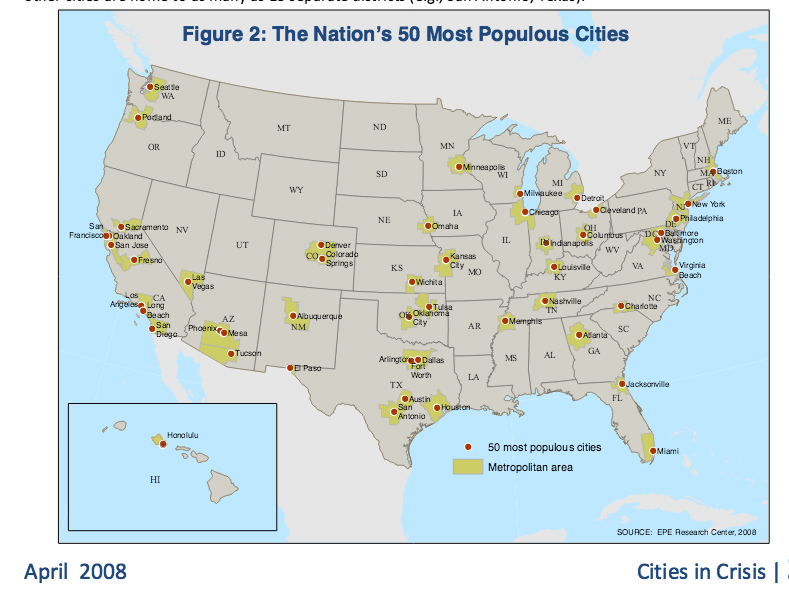
The biggest market shares were in the fifty largest cities where the “dropout factories” were ripe for school closures.
Marc Tucker’s National Institute for School Leadership (NISL) wasn’t far behind. He took a different approach to school closures but he continues, to this day, to use our money for his projects. Why isn’t that money going into public institutions?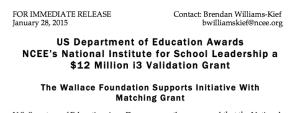
The oligarchy went on to use what they know will work… “disruptive innovation.”
“a process by which a product or service takes root initially in simple applications at the bottom of a market and then relentlessly moves up market , eventually displacing established competitors.”
Traditional public schools are seen as their competitors.
And they “never let a serious crisis go to waste.” Hurricane Katrina – school closures and re-opening as privately run charters. The Great Recession – an opportunity to accelerate the whole money-making plan using our Recovery Act dollars.
Over and over, they dangled autonomy, better teacher pay, and better schools in front of us. THEY — USED OUR INCESSANT WILLINGNESS TO SUPPORT SCHOOLS.
But, finally, the resistance to pseudo-reforms has been growing. It is a fight against the GERM – Global Education Reform Movement.
The oligarchy’s sustained campaign —outcome-based, neoliberal, greed-driven, pretense of reforms — isn’t unique to the U.S. because this is a global market. So what we see here in the U.S. is what is being seen the world over. We win a battle here and there but…
“…the same ‘reforms’ are again back after one year, albeit in a new package this time. What does this tells us? This tells us that even though the [resistance] movement was strong enough to highlight one specific and temporary aspect of the ‘reform’ agenda; it was not able to make popular the comprehensive critique of the whole process.”
We need to see their whole process.
As resistance to “disruptive innovations” rises, THEY will use “intervention design thinking principles” to manage the challenges involved in getting us “to engage with and adopt innovative new ideas and experiences.” But remember “innovative” or “new” doesn’t mean better schools for our kids. It more likely means a repackaged education product.
When will this nightmare end? It will only end when enough of us see that the oligarchy has used us, and, only we —collectively—have the power to stop it.

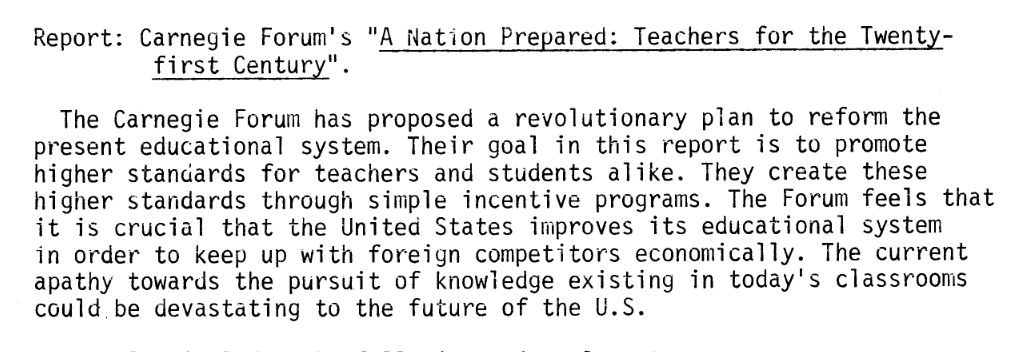
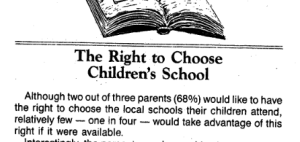

I don’t disagree with your analysis. But to resolve the core problem, one has to resist the temptation to differentiate between oligarchies; truth is that, given the same power, each of them (or any of us) will be equally evil. So the key is to ensure no one gets the amount of power that education oligarchies have now, and have had for the 150 years or so that compulsory schooling has existed.
It is the “compulsory” that creates the opening for oligarchy. A system that can commandeer 13 years of every child’s life is guaranteed to produce a certain cash flow through the economy, and the competition for that cash flow is bound to be fierce. How many incomes, pensions, and stock trades can be harvested from the backs of this generation? How can we increase that in the next generation? And who will do the harvesting?
The easiest way to fight the oligarchy is to collapse it under its own weight. To do this, one needs only to remove the two foundations of the system, the children, and the money.
There are some dramatic initial steps being taken in the direction of liberating the money. These are called Education Savings Accounts, in which parents can directly claim the education funding allotted to their child, and spend it on the education they feel is best suited to their child. Arrangements of this nature are now available to at least some parents in 5 US states.
But the liberating of the children is going a lot slower and as yet is only minimally codified in law. Yes, there are home educators, and yes, there alternate school models, but the legal right for parents to prevent their children from being cash cows for whatever oligarchy presently rules the massive education system is no closer to being realized than it was 50 years ago. And far from gaining soft rights in that direction, the concept of truancy as a crime is being RE-animated, with parents recently going to jail for their children’s non-attendance. Talk about your zombies – that concept should have remained dead and gone.
The only thing that will ever permanently reform education is for parents to go to court and demand that the rights and duties of parenthood be restored in full, and challenging the legally of enactments that confine all children to being raised in institutions. Can you imagine if compulsory schooling had never been enacted, and how societies would react if what exists today was proposed as a new idea? We would reject this theft of our children’s lives and defacto control of our societies out of hand. And so we should today, even if we have already been struggling under its burden for 150 years. The fact that it is habitual does not make it just.
I do see your points but have taken a different approach to solutions because of having a slightly different perspective of the core problem.
But what really has stopped me and made me think is a two-part question you ask in your last paragraph. It’s the first part I think we need to focus on, “Can you imagine if compulsory schooling had never been enacted?”
Now the last part is where I believe most of us find common ground. Can you imagine “how societies would react if what exists today was proposed as a new idea?”
Time will tell. We are just beginning to react.
Appreciate you commenting here 🙂
I think what shapes my agenda now is the realization that however we react, it’s basically futile. Every generation of parents has fought exactly the same battles that are going on today, and every generation has lost. Because the system we are fighting against has an institutional memory and the capacity to learn, it just gets better at fending off the public’s will with every go-’round, while every wave of parents starts from scratch, with no intergenerational learning. Even if we are spectacularly successful, they just need to wait till we transition out, and then they reverse whatever we’ve accomplished. In Canada, where I live, that tradition can be traced back to the 1950s, to a woman named Mary Johnson, whose battles on the reading front have been replicated innumerable times, with no net gain. There were others before her, I’m sure.
Knowing this history, my objective is to ensure that the next generation of parents does not have to do again what I did, or what you’ve done. The only way I see to do this is to ensure that their children are not in the grip of the system in the first place, and that they, not one oligarchy or another, are making the spending decisions.
The only place I see progress being made is in the courts. In the political arena, any of the oligarchies can outplay any parent or public group with one hand tied behind its back. Only in court is there any hope of a level playing field, and while the court system doesn’t always come through, cases like Vergara in California, and the legal decisions concerning Education Savings Accounts in several states, show that the capacity and potential are there.
But although we may disagree on how to spend time and energy, the important thing among allies is, I think, to recognize that none of us is wrong in what we are perceiving. There is something profoundly wrong with how modern societies are raising our children, and the effects are compounding with every successive generation. Any opposition to that status quo has merit.
Well said! And it is refreshing to know there is another person out there with exactly the same objective, “to ensure that the next generation of parents does not have to do again what I did, or what you’ve done.” That’s why I became an author. I became an author because I hoped that teachers and parents might read about what I learned and not repeat my mistakes. Its second edition is an expansion…more solutions focused.
While you see hope in the courts; I see hope in the law. Ours aims are so close. From here in the U.S., I can’t tell if my sight is set a bit to the right, left, up or down from yours…It might not matter if the target is big enough, and becomes vulnerable to being taken down.
I agree with your view that the courts are the most practical venue to achieve progress. While I see your point about the system’s “institutional memory,” I don’t feel that today’s parents are at as much of a a disadvantage as in the past.The instantaneous broad-based communication made possible by the Internet in recent years (leading to pages like this one) has done a lot to level the playing field, facilitating the existence of grassroots action & communication networks, allowing parents’ movements to build on past efforts in a way that previously was practical only for corporations.
Good point!
Lenny, there’s truth to what you say, but it’s my feeling that parents are at as much of a RELATIVE disadvantage as they’ve ever been.
Parents are certainly in a better position to inform themselves today than they have been in the past. Where it would have been difficult for Mary Johnson, in 1950s Winnipeg, to perceive that ineffective reading instruction was not a local problem but one common to school districts throughout the western world, today a concerned parent can ascertain that with just a few hours of internet browsing. Furthermore, concerned parents can connect with others to share and exchange observations.
But all that technology is also available to functionaries within the system. Thus we see that the communications apparatus within the system – whether it emanates from district, union, university, or state/federal agencies – is more sophisticated, and uses modern communications as subversively as it used to utilize and dominate the PTA and local media. They can also flood the internet with so much material that for those of us trying to mount an effective opposition, it’s like sipping from a fire hose, and you never know quite as much as the people who are producing the tsunami of schlock.
Also, the stakes have become higher as education spending has increased.
Finally, the sophistication of the communications industry has increased dramatically. If you have a look at the Frameworks Institute, a very skilled communications agency, you get an idea of the level of expertise that can be hired with our tax dollars to shape how we view what we’re trying to oppose 🙂
Re your earlier comment, Victoria, I don’t think it matters whether we’re left or right of each other! Our point of agreement is that only the law can free parents to best serve their children, and the law can be influenced through legislation (ie politics) or through the courts. It’s my contention though that only in court is the playing field close to level.
I think my key message is that it’s important to target the laws that create compulsory schooling, not to try to change the behaviour of system functionaries with the laws the way they currently are. That is futile, because functionaries cannot help but respond to the perverse incentive structure that a captive clientele presents them with.
I should have left my comment as “up or down” of yours instead of right or left since I meant it as if sighting-in a target – not politically. Political “sides” don’t matter to me as long as ensuring we are at least doing no more harm…doing the best by kids is ideal.
Pingback: Think Tanks, Fake News, Astroturfing, and Lies in the Era of Trump and DeVos - The Crucial Voice of the PeopleThe Crucial Voice of the People
Pingback: Renegade Researchers: In Education Hell - The Crucial Voice of the PeopleThe Crucial Voice of the People
Pingback: Zombie Ideas Are Killing Public Education - The Crucial Voice of the PeopleThe Crucial Voice of the People
Pingback: A Clear Plan: The Revolution in School Policy | The Crucial Voice of the PeopleThe Crucial Voice of the People
Pingback: Corporate-Elite Totalitarianism: Creeping or Leaping Toward a Totalitarian State? | The Crucial Voice of the PeopleThe Crucial Voice of the People